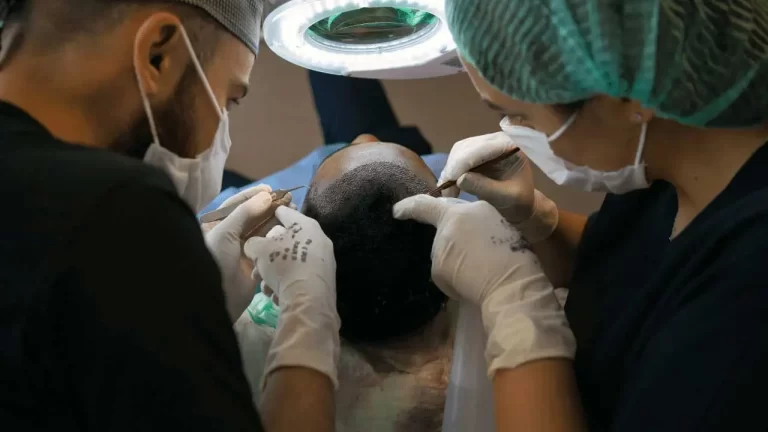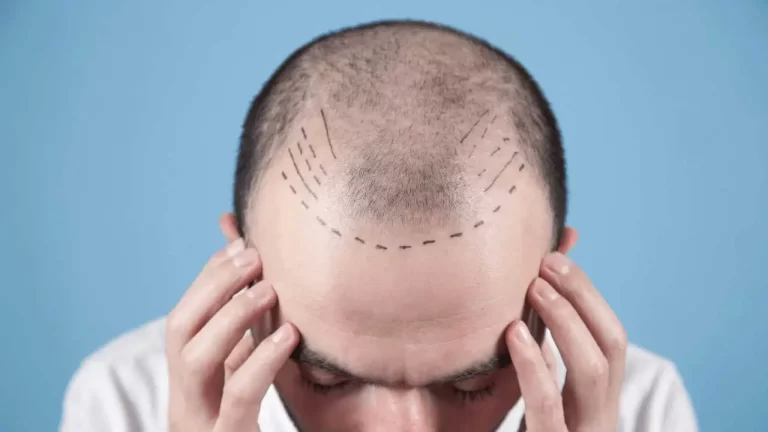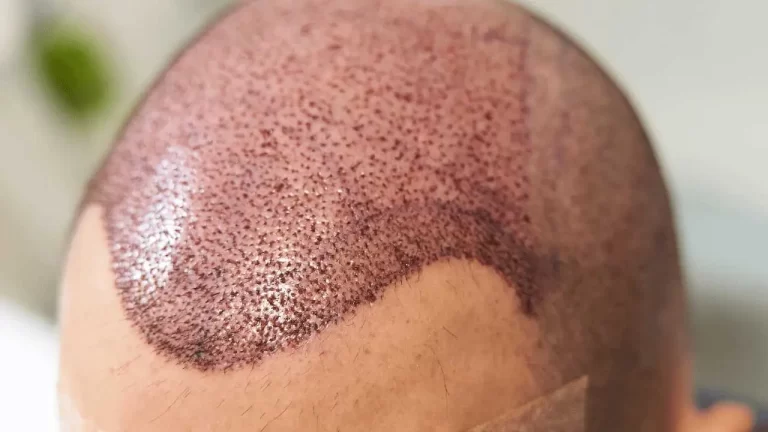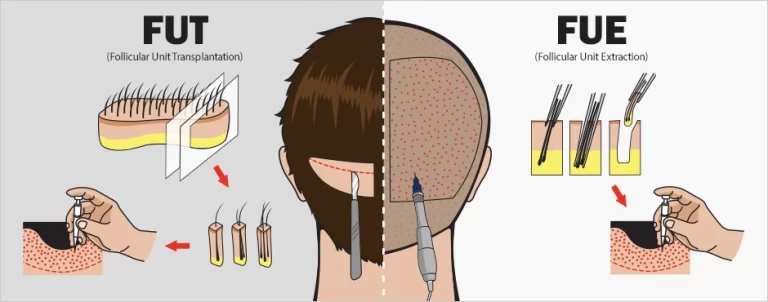What is Hair Transplantation?
Hair transplantation is a surgical procedure that involves moving hair follicles from one part of the body, known as the donor site, to another part, called the recipient site, where hair loss or thinning has occurred. It is primarily performed to treat male pattern baldness, but it can also be used to restore hair in women and to address hair loss due to injury or medical conditions.
Hair transplantation is a meticulous procedure that requires precision and expertise. It is typically performed under local anesthesia, ensuring that the patient is awake but numbed to any pain or discomfort. The surgeon removes individual hair follicles or strips of tissue containing follicles from the donor site, usually the back or sides of the scalp, and implants them into tiny incisions made in the recipient site.
The transplanted hair follicles are carefully placed to mimic the natural growth pattern and density of the surrounding hair. Over time, the transplanted hair follicles establish a blood supply and begin to grow new hair. The results of hair transplantation are generally permanent, providing a long-term solution to hair loss.

Reasons for Hair Transplantation and Who is a Suitable Candidate?
Hair transplantation is an option for individuals experiencing hair loss or thinning due to various reasons. The most common reason is male pattern baldness, a hereditary condition that causes gradual hair loss in a specific pattern, typically starting with a receding hairline and thinning at the crown. However, hair transplantation can also address hair loss resulting from:
Hormonal changes: Fluctuations in hormone levels, such as those that occur during menopause or pregnancy, can lead to temporary hair loss. In some cases, hair transplantation may be considered as a solution.
Trauma or injury: Accidents, burns, or surgeries can cause hair loss in specific areas. Hair transplantation can restore hair in these areas, improving the overall aesthetic appearance.
Medical conditions: Certain medical conditions, such as alopecia areata, which causes patchy hair loss, or trichotillomania, a hair-pulling disorder, may be treated with hair transplantation, depending on the individual case.
Scarring: Scars resulting from previous surgeries or injuries can cause permanent hair loss. Hair transplantation can help cover these scars by transplanting hair follicles into the scarred areas.
An ideal candidate for hair transplantation is someone who has sufficient hair follicles in the donor area and a stable supply of healthy hair. It is important to have realistic expectations regarding the outcome of the procedure. Hair transplantation may not be suitable for individuals with widespread hair loss or those with insufficient donor hair.

Advantages and Disadvantages of Hair Transplantation
Hair transplantation offers several advantages, making it a popular choice for individuals seeking to restore their hair:
Permanent solution: Unlike temporary solutions such as wigs or topical treatments, hair transplantation provides a long-term and permanent solution to hair loss. The transplanted hair continues to grow naturally, and regular hair care routines can be maintained.
Natural-looking results: Skilled surgeons carefully transplant individual hair follicles to mimic the natural growth pattern and density of the existing hair. This results in a natural-looking hairline and overall appearance.
Improved self-confidence: Hair loss can have a significant impact on self-esteem and confidence. Restoring a full head of hair through transplantation can boost self-confidence and improve overall quality of life.
Low maintenance: Once the transplanted hair has grown, it requires no special care or maintenance. It can be washed, styled, and treated just like natural hair.
Cost-effective in the long run: While hair transplantation may require an upfront investment, it can be cost-effective in the long run. Unlike temporary solutions that require ongoing maintenance and replacement, hair transplantation provides a permanent solution. This means that individuals do not have to continually spend money on wigs, hairpieces, or medications for hair growth. Over time, the cost of these temporary solutions can add up, making hair transplantation a more cost-effective option.
Improved quality of life: Hair loss can have a significant impact on a person's overall well-being and quality of life. It can affect their social interactions, relationships, and even career opportunities. By restoring their hair through transplantation, individuals can regain their self-esteem, feel more comfortable in social settings, and have a positive impact on their emotional well-being.
Versatility in styling: Transplanted hair is just like natural hair, allowing individuals to style it in various ways. They can choose different hairstyles, lengths, and even experiment with hair color if they desire. This versatility in styling options further enhances the benefits of hair transplantation.
Overall, hair transplantation offers a permanent, natural-looking solution for hair loss, improving self-confidence, and providing long-term cost-effectiveness. It can significantly enhance an individual's appearance, well-being, and quality of life, making it a popular choice for those seeking to restore their hair.

What is Hair Transplantation and How is it Performed?
Hair transplantation is a surgical procedure that involves the extraction of hair follicles from one part of the body, typically the back or sides of the scalp, and transplanting them to areas of the scalp where hair loss or thinning has occurred. This procedure is performed to restore hair growth in individuals who are experiencing baldness or significant hair loss.
Hair transplantation is a delicate and precise procedure that requires the expertise of a skilled surgeon. The process typically begins with a consultation, during which the surgeon assesses the patient's hair loss pattern and discusses their expectations and goals for the procedure. Once the patient and surgeon have agreed on the treatment plan, the hair transplantation procedure can be scheduled.
The first step in the procedure is the administration of local anesthesia to numb the scalp. This ensures that the patient remains comfortable throughout the surgery. Once the anesthesia has taken effect, the surgeon proceeds with the extraction of hair follicles from the donor area. This is done using one of two main techniques: Follicular Unit Extraction (FUE) or Follicular Unit Transplantation (FUT).

Types of Hair Transplantation
There are two main types of hair transplantation techniques: Follicular Unit Extraction (FUE) and Follicular Unit Transplantation (FUT). Each method has its advantages and considerations, and the choice between the two depends on the individual's specific circumstances and preferences.
FUE (Follicular Unit Extraction)
Follicular Unit Extraction, commonly known as FUE, is a hair transplantation technique that involves the extraction of individual hair follicles from the donor area. In this method, the surgeon uses a small, specialized tool to extract the follicles one by one. The extracted follicles are then carefully transplanted into the recipient area of the scalp, where hair growth is desired. FUE is a meticulous and time-consuming process, but it offers several advantages. It does not leave a linear scar, as individual follicles are extracted instead of a strip of tissue. This makes FUE a more suitable option for individuals who prefer to wear shorter hairstyles or have limited donor hair available.

FUT (Follicular Unit Transplantation)
Follicular Unit Transplantation, or FUT, is another commonly used technique in hair transplantation. In this method, a strip of scalp tissue is surgically removed from the donor area, typically the back of the scalp. The skilled surgical team then dissects the strip to obtain individual hair follicles for transplantation. The incision made during the extraction process is meticulously closed with sutures.
One advantage of FUT is that it allows for the transplantation of a large number of hair follicles in a single session. This can be beneficial for individuals with extensive hair loss or those who desire maximum coverage in a shorter period. However, it does leave a linear scar at the donor site, which can be concealed by surrounding hair but may limit hairstyle options in the future.

Recovery and Post-Transplant Care
After a hair transplantation procedure, it is essential to follow the post-operative care instructions provided by the surgeon. This typically includes taking prescribed medications to prevent infection, minimize swelling, and promote healing. It is common to experience some discomfort, swelling, and scabbing in the recipient and donor areas, which gradually subsides over time.
During the recovery period, it is crucial to protect the transplanted area from direct sunlight, excessive sweating, and any activities that may cause trauma to the scalp. The surgeon may advise avoiding strenuous exercise, swimming, and the use of hair styling products for a certain period. It is essential to keep the scalp clean and follow the recommended washing routine provided by the surgeon.
The transplanted hair follicles undergo a shedding phase within the first few weeks after the procedure. This shedding is a normal part of the hair growth cycle and should not cause concern. After shedding, new hair growth gradually begins, and it takes several months for the transplanted hair to fully grow in. The final results of the hair transplantation procedure can typically be seen within 9 to 12 months.
